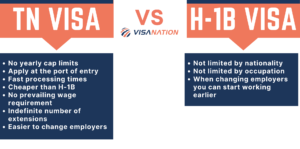H-1B Visa vs TN Visa for Mexicans and Canadians
If you are a foreign professional interested in bringing your skills to a company in the United States, yet aren’t sure whether to pursue the H-1B or TN visa classifications, you’re not alone. Depending on your circumstances, either option could be a better fit for you. However, if you are a resident of Canada or Mexico, the advantages of a TN visa tend to outweigh the H-1B visa. Understanding the differences with the help of a qualified attorney can help you make the right immigration decision. This page will allow you to make the right decision between a TN visa vs H-1B visa.
What is an H-1B Visa?
A non-immigrant visa, H-1B status allows companies in the United States to employ graduate-level workers from all over the world in specialty occupations in the sciences and mathematics realm such as accountants, architects, engineers, doctors, and IT professionals.
Learn about: O-1 Visa for Computer Scientists and Software Engineers.
What is a TN Visa?
Created under the North American Free Trade Agreement (NAFTA) between the United States, Canada, and Mexico, the TN (Treaty NAFTA) visa is perhaps the most useful of all of the NAFTA-related visas.
Modeled after the H-1B visa, the TN visa may only be used for a United States-based company and a Canadian or Mexican candidate who meets the education requirements and works at a professional level within one of the 63 approved occupations.
H-1B and TN Visa Differences
TN visa can be considered a better choice for someone from Mexico or Canada because it makes the process easier for citizens of those countries and doesn’t have a yearly cap limit. On the other hand, H-1B is more encompassing as it doesn’t have a limit on occupations like the TN visa. There are plenty more differences and reasons why one visa is better than the other. The following information breaks down the differences between the two visas in order to help you decide which you may need to apply for based on your current situation.
By looking at the differences between the H-1B visa and the TN visa, we’ll also point out where we see the benefits of a TN visa over the H-1B and vice versa.
Benefits of TN over H-1B
Advantages of H-1B over TN
Citizenship Requirements
To secure H-1B visa status you may be a citizen of any country. However, TN visa status is available only for the citizens of Mexico or Canada and unavailable for permanent residents or landed immigrants.
Landed immigrants refer to people who have relocated and changed their permanent residence to a state where they are granted limited rights that are associated with residency, yet they do not hold citizenship.
Numerical Limitations
The United States Citizenship and Immigration Services (USCIS) puts a yearly cap on H-1B visas. Each fiscal year, only 65,000 petitions are accepted from applicants that hold bachelor’s degrees as well as an additional 20,000 from those who have master’s degrees.
On the other hand, the USCIS does not limit the amount of available TN visas, making it easier to obtain them.
The Application Process
Canadians Outside the United States
The TN visa requires Canadian citizens to initially apply in person at a U.S. port of entry or airport when coming from outside the United States. The H-1B visa requires Canadians who are outside the U.S. to have their employer file an I-129 petition with the USCIS, as well as present an I-797 form.
The I-129 petition is used by employers or prospective employers to obtain a worker on a nonimmigrant visa status. The I-797 is a receipt notice given by the USCIS to the applicant or petitioner of a visa. The receipt is not an actual grant of approval of permission.
Mexicans Outside the United States
The initial step for Mexicans who are outside the United States is to obtain a TN visa stamp. They can then apply in person once they reach a U.S. port of entry or airport.
To obtain the H-1B visa, Mexicans must go through the same process as Canadians with regard to the I-129 petition, as well as the I-797 approval notice.
Canadians and Mexicans Within the United States
Employers of Canadians and Mexicans within the United States may file the I-129 petition with the USCIS for the TN visa as well as an extension or change of status. The same goes for the H-1B visa
Because the TN visa can be applied for at the U.S. port of entry without having to submit petitions to the USCIS, the application process will be a benefit of TN over H-1B.
Processing Time
The processing time for the TN visa can be exceptionally quick. As long as you have the proper documents, they can be processed at a U.S. port of entry. This is extremely advantageous for a company that may have a pressing need for a particular employee.
The H-1B visa processing time is usually much slower in contrast. This is because the application entails obtaining labor condition application certification and waiting for the approval of the H-1B petition. You must then wait for the USCIS to process each step.
Government Filing Fees
TN Visa for Canadians
An application fee of $50 plus $6 for an I-94 card fee must be paid at the United States border or airport. An I-94 card is the arrival and departure record for a nonimmigrant visitor.
TN Visa for Mexicans
There is a visa application fee of $160.
It is important to note that a filing fee of $460 is charged for an I-129 petition for a change or extension of status.
H-1B Visa
There is an I-129 petition filing fee of $460, a fee (unless you are exempt) of either $750 or $1,500 for data collection and filing, as well as a fee of $500 for fraud prevention and detection.
Government filing fees are much less for the TN visa, so that would be a benefit of TN over H-1B.
Occupational Categories Available
You are eligible for H-1B visa status if you are employed in an occupation that would require earning a bachelor’s degree in the U.S. However, the TN visa limits itself to sixty-three (63) approved occupations.
Due to the fact that H-1B is inclusive to all occupations while TN has limits, this would be an advantage of H-1B over TN.
Prevailing Wage Requirements
The prevailing wage is the hourly wage, including overtime as well as benefits, which is paid to a worker or laborer. Most employment-based visa programs that involve the United States Department of Labor (DOL) require that you, the employer, pay at least the prevailing wage to your employees.
For TN visas, there is no prevailing wage requirement set under United States immigration laws. In stark contrast, under H-1B visas, employees must be paid 100% of the prevailing wage requirement based on their occupation. Depending on whether you are the employer or the worker, this can be either an advantage or a disadvantage.
Authorized Period of Stay
The time that the USCIS allows you to stay in the United States is defined as an “authorized period of stay”. If this period expires and you remain in the country, thereby violating the conditions of your admission, the government then defines that as an “unlawful presence”.
While both the H-1B visa and the TN visa have a three-year limit, there are some slight differences once you try to extend that visa. For instance, the TN visa allows for an indefinite number of three-year extensions. An additional three-year period of stay is available through the H-1B visa program, but once that six-year limit has been reached, you must leave the United States for at least one year unless the time can be recaptured or you have started the green card process.
If you file for a green card, however, your stay may be extended beyond the six-year limit without having to leave the country for a year. Indefinite three-year extensions make the period of stay a benefit of TN over H-1B.
Changing or Extending Visa Status
TN Visa Status for Canadian Citizens
Canadians may change or extend their TN visa status at a U.S. port of entry or by having their employer file an I-129 petition with the USCIS.
TN Visa Status for Mexican Citizens
In order to change or extend their TN visa status, Mexicans need to initially obtain a TN visa stamp. Then, just like the process for Canadians, they can apply at a U.S. port of entry or by having their employer file the I-129.
H-1B Visa Status
The only way to change or extend H-1B visa status is by having your employer file an I-129 petition. Because you are not able to alter your status at a port of entry, this is a disadvantage of the H-1B.
Change of Employer
Change of Employer –TN Visa Status for Canadians and Mexicans
You are allowed to change your employer at any time, even though TN visa status is employer-specific. Just like extending or changing status, you can have your new employer apply for the change at a port of entry or by filing the I-129.
For both Canadians and Mexicans, if they file the I-129 petition with the USCIS, they are not allowed to work until the petition is approved. Visit the USCIS to learn more about the differences between the Canadian and Mexican processes for changing employers.
Change of Employer – H-1B Visa Status
If you would like to change your employer while under H-1B visa status, you simply need to file an I-129 petition with the USCIS. The biggest difference between the TN visa and the H-1B visa regarding a change of employer is that under H-1B visa status, you may start work upon the “receipt” of the petition, not “approval”.
Even though this might seem like an advantage of H-1B over TN, many would opt to apply for a change of employer at a U.S. port of entry through TN status.
Transfer to New Job Location
If you continue to work for the same employer and provide the same services, no action is required under TN visa status if you change job locations. However, under H-1B visa status, your employer would need to file an amended I-129 petition along with a labor condition application.
Immigrant Intent (Dual Intent)
A nonimmigrant with an H-1B visa may have “dual intent” if they enter the United States to work while also intending to immediately apply for a green card. Therefore, H-1B holders can pursue permanent residency without affecting their current nonimmigrant status.
Individuals with TN visa status are generally not allowed to seek permanent residence or apply for a green card. This advantage is one of the reasons why H-1B visa status is so highly coveted.
Change from TN Visa to H-1B Visa
Many would like to change from a TN visa to an H-1B because the latter allows you to gain permanent residency in the U.S. The process is relatively simple, as you would have to apply for an H-1B visa. Unfortunately, there are not any special arrangements for changing between the two visas.
There are two scenarios that are relevant here. First is where you have an entirely new company willing to sponsor your H-1B visa. The downside of this scenario is that if your application does not get selected and you have terminated employment with your TN visa sponsor, you may lose your U.S. residency status.
The second scenario is where your existing TN visa employer is willing to sponsor your H-1B visa. This situation is much more favorable because if your H-1B application is not selected, then you will still be able to work and retain your residency status through the TN visa.
Although your application process may differ, changing from a TN visa to an H-1B visa will generally take the following steps:
Step 1: Your employer files Labor Condition Application.
Step 2: Your employer obtains a Prevailing Wage Determination.
Step 3: Your employer submits Form ETA-9035.
Step 4: Your employer files Form I-129, Petition for Non-immigrant Worker.
Step 5: If selected, USCIS will update your I-94, and you will have to get your H-1B visa stamped by submitting DS-160.
TN Visa vs H-1B Statistics
Below you will find TN and H-1B statistics for the past 10 years. We regularly update this data and 2022 statistics will be published as soon as they are available.






